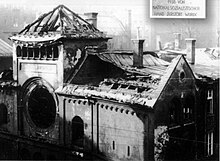A ruined synagogue in Munich after Kristallnacht
Hermann Göring met with other members of the Nazi leadership on 12 November to plan the next steps after the riot, setting the stage for formal government action. In the transcript of the meeting, Göring said,
‘I have received a letter written on the Führer‘s orders requesting that the Jewish question be now, once and for all, coordinated and solved one way or another… I should not want to leave any doubt, gentlemen, as to the aim of today’s meeting. We have not come together merely to talk again, but to make decisions, and I implore competent agencies to take all measures for the elimination of the Jew from the German economy, and to submit them to me.”
The violence was officially called to a stop by Goebbels on 11 November, but violence continued against the Jews in the concentration camps despite orders requesting “special treatment” to ensure that this did not happen. On 23 November, the News Chronicle of London published an article on an incident which took place at the concentration camp of Sachsenhausen. Sixty-two Jews suffered punishment so severe that the police, “unable to bear their cries, turned their backs”. They were beaten until they fell and, when they fell, they were further beaten. At the end of it, “twelve of the sixty-two were dead, their skulls smashed. The others were all unconscious. The eyes of some had been knocked out, their faces flattened and shapeless”. The 30,000 Jewish men who had been imprisoned during Kristallnacht were released over the next three months but, by then, more than 2,000 had died.

